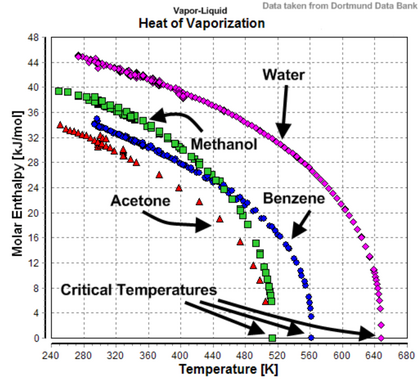

What is Heat of Vaporization?
Heat of Vaporization Formula : Heat of vaporization, often denoted as ΔHvap, is the amount of heat energy required to change a substance from its liquid phase to its gaseous phase at a constant temperature and pressure. It is a fundamental concept in thermodynamics and plays a significant role in various industrial processes, including distillation and refrigeration. Heat of vaporization, often denoted as ΔHvap, is the amount of heat energy required to change a substance from its liquid phase to its gaseous phase at a constant temperature and pressure. It is a fundamental concept in thermodynamics and plays a significant role in various industrial processes, including distillation and refrigeration.The Formula for Heat of Vaporization
The formula to calculate the heat of vaporization is given by:ΔHvap = (mass of substance) × (heat of vaporization per unit mass)
Where: - ΔHvap is the heat of vaporization (in joules or calories) - Mass of substance is the mass of the substance undergoing vaporization (in grams or kilograms) - Heat of vaporization per unit mass is the amount of heat energy required to vaporize one unit of mass (in joules per gram or calories per gram)
Also Check - Heat Input Formula
Solved Examples Of Heat of Vaporization Formula
Example 1:Calculate the heat of vaporization for 50 grams of water. The heat of vaporization of water is 40.7 kJ/mol.
Solution:
First, we need to convert grams to moles using the molar mass of water (18.015 g/mol): Number of moles (n) = Mass (m) / Molar mass (M) n = 50 g / 18.015 g/mol ≈ 2.776 mol Now, we can calculate the heat of vaporization: ΔHvap = n × ΔHvap per mole ΔHvap = 2.776 mol × 40.7 kJ/mol ≈ 112.91 kJ So, the heat of vaporization for 50 grams of water is approximately 112.91 kJ.Also Check - Critical Velocity Formula
Example 2:Calculate the heat of vaporization for 100 grams of ethanol (C2H5OH). The heat of vaporization of ethanol is 38.56 kJ/mol.
Solution:
- Calculate the molar mass of ethanol:
- Convert grams to moles:
- Calculate the heat of vaporization:
Also Check - Shear Modulus Formula
Example 3:Find the heat of vaporization for 500 grams of ammonia (NH3). The heat of vaporization of ammonia is 23.35 kJ/mol.
Solution:
- Calculate the molar mass of ammonia:
- Convert grams to moles:
- Calculate the heat of vaporization:
Also Check - Soil Erosion Formula
Applications Of Heat of Vaporization Formula
- Distillation: Heat of vaporization is vital in distillation processes, separating liquids based on their differing boiling points, such as in the production of alcoholic beverages and petroleum refining.
- Refrigeration: Refrigeration and air conditioning systems use the heat of vaporization to cool substances by evaporating refrigerants inside coils, absorbing heat from the surroundings.
- Food Industry: In cooking and food preservation, understanding the heat of vaporization is crucial for maintaining food texture and taste during processes like boiling, steaming, and baking.
- Chemical Reactions : Heat of vaporization plays a role in various chemical reactions involving phase changes, such as in the synthesis of pharmaceuticals and chemical manufacturing.
- Power Plants: Steam turbines in power generation plants utilize the heat of vaporization to produce mechanical energy by expanding high-pressure steam.
- Environmental Science: In meteorology, the heat of vaporization is essential for understanding weather phenomena like evaporation, condensation, and cloud formation, which impact climate and precipitation patterns.
Heat of Vaporization Formula FAQs
What is the significance of heat of vaporization in everyday life?
Heat of vaporization is crucial for understanding processes like cooking, where water evaporates, and in industries like distillation and refrigeration.
Can the heat of vaporization change with temperature and pressure?
Yes, it can vary with temperature and pressure. However, it's typically measured at standard conditions.
What units are used to express heat of vaporization?
Heat of vaporization is often expressed in joules per gram (J/g) or calories per gram (cal/g).
Can heat of vaporization be negative?
No, it is always positive because it represents energy input to change a substance from liquid to gas.
🔥 Trending Blogs
Talk to a counsellorHave doubts? Our support team will be happy to assist you!

Check out these Related Articles
Free Learning Resources
PW Books
Notes (Class 10-12)
PW Study Materials
Notes (Class 6-9)
Ncert Solutions
Govt Exams
Class 6th to 12th Online Courses
Govt Job Exams Courses
UPSC Coaching
Defence Exam Coaching
Gate Exam Coaching
Other Exams
Know about Physics Wallah
Physics Wallah is an Indian edtech platform that provides accessible & comprehensive learning experiences to students from Class 6th to postgraduate level. We also provide extensive NCERT solutions, sample paper, NEET, JEE Mains, BITSAT previous year papers & more such resources to students. Physics Wallah also caters to over 3.5 million registered students and over 78 lakh+ Youtube subscribers with 4.8 rating on its app.
We Stand Out because
We provide students with intensive courses with India’s qualified & experienced faculties & mentors. PW strives to make the learning experience comprehensive and accessible for students of all sections of society. We believe in empowering every single student who couldn't dream of a good career in engineering and medical field earlier.
Our Key Focus Areas
Physics Wallah's main focus is to make the learning experience as economical as possible for all students. With our affordable courses like Lakshya, Udaan and Arjuna and many others, we have been able to provide a platform for lakhs of aspirants. From providing Chemistry, Maths, Physics formula to giving e-books of eminent authors like RD Sharma, RS Aggarwal and Lakhmir Singh, PW focuses on every single student's need for preparation.
What Makes Us Different
Physics Wallah strives to develop a comprehensive pedagogical structure for students, where they get a state-of-the-art learning experience with study material and resources. Apart from catering students preparing for JEE Mains and NEET, PW also provides study material for each state board like Uttar Pradesh, Bihar, and others
Copyright © 2025 Physicswallah Limited All rights reserved.











